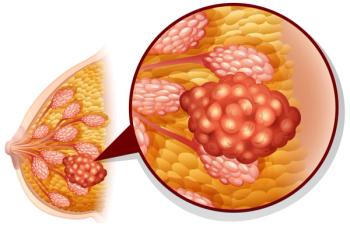
Fulvestrant Plus Capivasertib Improved Survival Vs Fulvestrant/Placebo in ER+, HER2– Advanced Breast Cancer
Findings from the phase 1/2 FAKTION trial indicated that survival had increased following the addition of capivasertib to fulvestrant for patients with aromatase inhibitor–resistant, estrogen receptor–positive, HER2-negative advanced breast cancer.
The addition of capivasertib to fulvestrant (Faslodex) prolonged survival in patients with aromatase inhibitor–resistant, estrogen receptor–positive, HER2-negative advanced breast cancer compared with fulvestrant and placebo, according to results from the phase 1/2 FAKTION trial (NCT01992952) published in Lancet Oncology.
The median progression-free survival (PFS) was 10.3 months (95% CI, 5.0-13.4) in fulvestrant plus capivasertib arm vs 4.8 months (95% CI, 3.1-7.9) in the placebo arm (adjusted hazard ratio [aHR], 0.58; 95% CI, 0.39-0.84; 2-sided P = .0044). Moreover, median overall survival (OS) in the fulvestrant plus capivasertib arm was 29.3 months (95% CI, 23.7-39.0) vs 23.4 months (95% CI, 18.7-32.7) in the placebo arm (aHR, 0.66; 95% CI, 0.45-0.97; 2-sided P = .035). In the intent-to-treat population (ITT), 71% of patients in the fulvestrant plus capivasertib group died vs 83% in the placebo group.
A total of 183 patients were screened for eligibility, of whom 140 enrolled and were randomly assigned to either the fulvestrant plus capivasertib arm (n = 69) or the placebo arm (n = 71). The median follow-up was 58.5 months in the fulvestrant plus capivasertib arm and 62.3 months in the placebo arm.
Moreover, 54% of patients had PIK3CA, AKT1, and PTEN alterations and 25% had alterations identified in tumors previously believed to be non-altered. Both groups were balanced for the proportion of patients with PIK3CA mutations vs AKT1 mutations vs PTEN alterations.
For those in the expanded altered pathway subgroup, the median follow-up was 54.3 months in the fulvestrant plus capivasertib group and 62.3 months in the placebo group. For those in the expanded pathway non-altered group, the median follow-up was 60.9 months in the fulvestrant plus capivasertib group and 70.3 months in the placebo group.
In the pathway-altered subgroup, the PFS was 12.8 (95% CI, 6.6-18.8) months in the fulvestrant plus capivasertib group vs 4.6 months (95% CI, 2.8-7.9) in the placebo group (aHR, 0.44; 95% CI, 0.26-0.72; 2-sided P = .0014). In the expanded pathway non-altered group, the median PFS was 7.7 months (95% CI, 3.1-13.2) in the fulvestrant plus capivasertib group vs 4.9 months (95% CI, 3.2-10.5) in the placebo group (aHR, 0.70; 95% CI, 0.40-1.25; P = .23).
Of those in the expanded pathway altered group, 64% in the fulvestrant plus capivasertib group had died vs 86% in the placebo group. In the non-altered group, 80% of patients in both groups, respectively, had died.
Next-generation sequencing (NGS) and digital droplet PCR results were obtained from 79% of patients in the placebo group, 81% of patients in the fulvestrant plus capivasertib group, and 80% in the ITT population. Of those who did not have an additional plasma or tissue sample available and did not undergo NGS, 19% were in the fulvestrant plus capivasertib arm and 21% were in the placebo arm. Of note, the NGS identified several PIK3CA mutations, AKT1, or PTEN loss of function alterations that were not reported in initial testing.
The most common grade 3/4 adverse effects (AEs) in the fulvestrant plus capivasertib and placebo groups, respectively, were hypertension (32% vs 25%), diarrhea (14% vs 4%), and rash (20% vs 0%). Serious AEs included pneumonia in the fulvestrant plus capivasertib arm. There was 1 death due to atypical pulmonary infection in the fulvestrant plus capivasertib group which may have been related to treatment. Another death in the same treatment arm occurred 1 year after treatment due to a thrombotic cerebrovascular accident. Deaths with an unknown cause included 4 in the fulvestrant plus capivasertib group and 3 in the placebo group, with the remaining 43 and 56 deaths, respectively, being disease related.
Reference
Howell SJ, Casbard A, Carucci M, et al. Fulvestrant plus capivasertib versus placebo after relapse or progression on an aromatase inhibitor in metastatic, oestrogen receptor-positive, HER2-negative breast cancer (FAKTION): overall survival, updated progression-free survival, and expanded biomarker analysis from a randomised, phase 2 trial. Lancet Oncol. 2022;23(7):851-864. doi:10.1016/S1470-2045(22)00284-4
Newsletter
Stay up to date on recent advances in the multidisciplinary approach to cancer.




